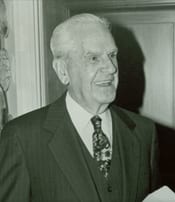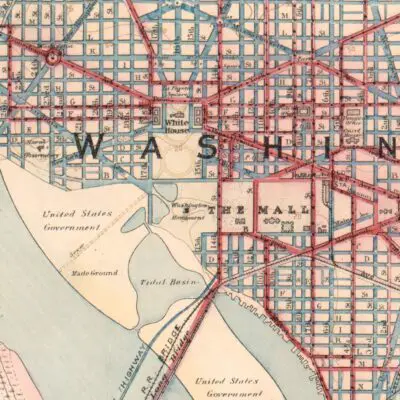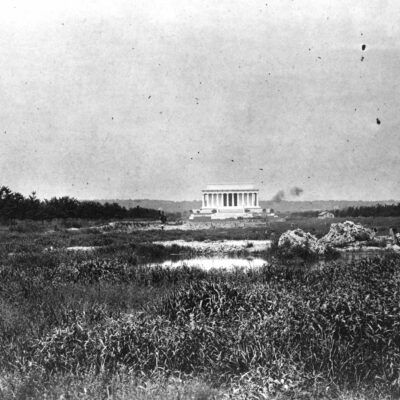This is a story that is most likely unknown to the great majority of GoDCers. Long-time DC residents may remember the controversy over the bridge that was to be built, connecting Virginia and the District, right over The Three Sisters (why are they named Three Sisters?). The bridge would have landed in D.C. right where Canal Rd and Foxhall Rd. intersect.
Things would be dramatically different in our city if this had come to fruition. In order to orient yourself, take a look at the map below to see where the bridge would have been and then read the rest of the story below.
A bridge at this location wasn’t something unique to the latest proposal from the 1950s. The idea dates back to 1789 when the first proposal to build a crossing was put forward by none other than Pierre L’Enfant. No less than half a dozen proposals followed but this latest one from the 1950s is what we’re going to share.
In 1957, New Jersey Senator Clifford Case proposed legislation to have a bridge built at Three Sisters. Nothing came of that initial proposal, but by 1959, a government study included this new bridge over the Potomac as part of a needed hub-spoke-and-wheel highway system for Washington.
Below are some design proposals printed in The Washington Post on September 21st, 1967. The last one is horrendous.

Later in 1960, the D.C. Highway Department formally proposed the Three Sisters Bridge as part of their interstate highway plans. The goal was to extend Whitehurst Freeway over Canal Road NW up to the Georgetown Reservoir and be renamed the Potomac River Freeway. Remember, these were the days where entire cities were being reshaped in the mold of full car living. A spur from this new extended highway would cross the Potomac at Three Sisters and intersect with the George Washington Parkway and the planned I-66.
Below is an article that we came across in The Washington Post, printed on April 30th, 1959.
District an Virginia highway officials have agree tentatively that the next upstream bridge across the Potomac should be built at Three Sisters Islands.
…
The bridge would connect the Potomac Freeway, the Glover-Archbold Parkway and the Palisades Parkway on the District side of the river with George Washington Memorial Parkway and possibly with Interstate Route 66 on the Virginia Side. Of these, only the Washington Parkway in Virginia is now being built.
Aitken said Virginia is considering the connection with the interstate route, using a link that would cross the Washington Parkway about where Spout Run Parkway inland from the river in Arlington.
…
The location is one of three considered by highway and planning bodies in recent years. The others are at the foot of Arizona ave. nw. and at the foot of Nebraska ave. nw., both farther upstream.
…
One advantage of the Three Sisters location, he declared, is its truck-carrying potential. No trucks will be permitted on the Theodore Roosevelt Bridge at Constitution ave. nw., he pointed out. The Roosevelt crossing will handle auto traffic off the interstate highway.

According to reports, the freeway and six-lane, 160-foot bridge were to begin construction in late 1962 and open to traffic in 1966 after a total investment of $28.5 million. The bridge wasn’t without its loud opposition though, the Foxhall Community Citizens Association (which is still around) being among those.
Congress passed legislation in 1960 to establish the National Capital Transportation Agency (NCTA) which would oversee the upcoming development and expansion of public transit as well as new highways through the city. The legislation also established a moratorium on any highway or bridge construction west of 12th St. NW until July 1st, 1965, placing the Three Sisters project on hold.
By January 1st, 1967, a new cabinet-level agency was established with the U.S. Department of Transportation, which had jurisdiction over projects like this one. Alan Boyd headed up the department and he was against both the bridge project and the proposed highway projects cutting through D.C. His skepticism and acknowledgement that local opposition was extremely strong led him to pause the project in May 1967 in order for deeper studies to be performed on its potential impact on area neighborhoods.

Source: DDOT DC
In parallel, in June 1967, President Lyndon Johnson reorganized the District’s city government, removing the three-member commission, replacing it with an appointed mayor (Walter Washington) and a new nine-member commission. The new commission voted to opposed the construction, putting the city government squarely against the project and some angry and powerful congressmen, including Democratic Rep. John Kluczynski of Illinois and Democratic Rep. William Natcher of Kentucky.

Source: DDOT DC

Natcher was chairman of the House Subcommittee on Appropriations and keen on bringing funding to pet projects at home in Kentucky. He used his position of support for the Three Sisters project to win favors from others to support funding his projects in Kentucky. He even went so far as to threaten withholding all funding for the nascent Metro project in D.C. unless the administrator of the NCTA, William McCarter supported the bridge, which he eventually did.
Kluczynski was chairman of the Subcommittee on Roads under the House Committee on Public Works, not to mention a huge supporter of the highway industry (where I’m sure he received a healthy number of political donations). He pushed through an amendment which required the District to disregard and court rulings against the bridge project, forcing them to push forward. It was signed into law in August 1968 by President Johnson.

Later that year, with the election moving forward, Johnson had the remaining months of a lame duck presidency and what appeared to be the final nail in the coffin for the bridge was when his administration deleted plans for the bridge from the official National Capital Planning Commission’s highway plan.
Nixon entered the White House the following January and it was known that he and his Secretary of Transportation, John Volpe, was against the Washington Metro. Natcher reemerges as the strong voice for the bridge, again threatening to remove all funding for Metro if the Three Sisters Bridge was not constructed. The city council voted that summer to approve the bridge, and it was put back into the official highway planning documents for the area.
It was such a hotly contested issue in the city at the time, with clearly nobody in the general public supporting it. Over 85 percent of city voters in a general election ballot for November 1969 voted against it. A total of 9,990 voters turned out and only 1,836 were in favor of the bridge. The day before the election, construction trailers at the site were firebombed. Below is the mention of this incident in The Washington Post.
Two construction trailers at the site of the controversial Three Sisters Bridge were destroyed by fire yesterday.
Police said the trailers and their contents, owned by the Head Construction Co., were valued at $14,000.
They said the fires, which broke out shortly after 5:30 a.m., apparently were started by “fire bombs.”
A couple weeks earlier, on October 15th, 141 protesters were arrested at the construction site, demonstrating against the project, shouting “Stop the bridge, free D.C.” and “Power to the people.” A large number of the protesters were students from both Georgetown and George Washington. Students even took to boating out to Three Sisters and even camping overnight to occupy the islands. At times, up to 100 students were occupying the islands simultaneously, planting an American flag and large banner with the words “Stop the Bridge” fluttering in the wind.

Source: A Trip Within the Beltway
The occupation was organized by a 23-year-old Georgetown graduate student, Matt Andrea of the D.C. Student Committee on the Transportation Crisis (DCSCTC). Andrea said that it was important to see the link between the “immoral war in Vietnam” to the “war here against the poor of the inner city,” referring to the entire city highway plan which called for razing hundreds of homes, displacing thousands of poorer D.C. residents.
I did a little Googling to see what I could find, and maybe this is him on LinkedIn?
Nothing the protests did was able to halt progress on the bridge. The two congressmen were in a position of power and refused to budge. Local community and neighborhood groups banded together to take their appeals through the formal legal process and ultimately stop the bridge construction.
In August 1970 a court ruling was made stating that political pressure was the primary factor in the approval of the bridge, citing the threat by Natcher to withhold funding from Metro. Construction on the bridge ceased on August 27th even though the support piers had already risen to just below the surface of the Potomac. The U.S. Court of Appeals issued a 34-page ruling in October 1971 that Secretary of Transportation John Volpe had not properly followed federal laws and regulations in approving the bridge.
On direct order from President Nixon, the Department of Justice asked the Supreme Court to hear an appeal on the Three Sisters ruling in January 1972, but the Court declined, leaving the final ruling on D.C. Federation of Civic Associations v. Volpe intact. The plaintiffs case was argued by Roberts B. Owen and Gerald P. Norton of Covington & Burling.

Source: A Trip Within the Beltway
Ultimately, activists and community organizations won out over bridge advocates and construction was formally cancelled in 1972. Mother nature came in and took care of the rest when Hurricane Agnes struck June 21st, sweeping away the bridge’s unfinished support piers. In May 1977, the Department of Transportation allowed D.C. to remove the Three Sisters Bridge from its master transportation plan, killing the project for good.
Rep. Natcher stayed in Congress until his death at the age of 84 on March 29th, 1994. He served in Congress for an impressive 41 years. Today, Brett Guthrie holds Natcher’s seat representing the 2nd district of Kentucky since 2009. Rep. Kluczynski served the Illinois 5th for 24 years until his death at the age of 78 on January 26th, 1975. His seat in the House is currently occupied since 2009 by Mike Quigley, who was preceded by former White House Chief of Staff and current Chicago Mayor Rahm Emanuel.
And so goes the fascinating and dramatic story of the unbuilt Three Sisters Bridge. The city would be dramatically different if we had a looming bridge over the Potomac north of Key Bridge. Thankfully, strong community voices banded together to halt the project leaving the Three Sisters alone. Make sure you read up on the history of the islands, dating back to Native American times.
There’s a great book by Zachary Schrag called The Great Society Subway, about the history of Washington’s Metro that includes a lot of this story. I highly recommend it. Also, are some great images by DDOT on Flickr showing what the bridge might have looked like.



















